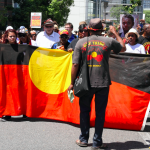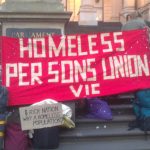From the Prison Cell to the Street and Back Again

Imprisonment rates in Australia are at an all-time high. At the end of March this year, there were 12,955 adult inmates in NSW correctional facilities, according to NSW Bureau of Crime Statistics and Research figures.
The overwhelming majority of these prisoners are going to be released back into the community. And one of the key factors that will enable them to successfully reintegrate and avoid reoffending is being able to access stable housing.
UNSW professor of criminology Elieen Baldry’s ground breaking research from over a decade ago found that inmates who had to move three times within their first year of release were significantly more likely to return to prison, than those who didn’t move or moved only once.
However, for a growing number of inmates on the outside the opportunity to secure even an initial place to live is beyond them. Australia-wide there’s a lack of affordable housing, and in cities like Sydney and Melbourne renting a room in a boarding house can even be expensive.
During the 12 months ending June 2016, 3,950 Australians who on being released from prison sought homelessness services. This was a 54 percent increase over the last three years, data compiled by the Australian Institute of Health and Welfare (AIHW) shows.
A 2015 AIHW report reveals that there’s a virtual revolving door between homelessness and incarceration. Twenty five percent of people entering prison in Australia were found to be homeless immediately prior to going to prison, and 31 percent reported being so on release.
A lack of reintegration support
Senior policy and research officer at Homelessness NSW Digby Hughes told Sydney Criminal Lawyers® that there needs to be more affordable housing available for inmates being released, as well as support programs that begin on the inside and continue post-release.
“What we’ve been arguing for now and discussing with government is a throughcare policy,” Mr Hughes said. These programs would teach inmates the skills they need to stay out of prison, and also “ensure they actually have housing when they leave.”
At the moment, “there’s not a lot of proactive work to make sure that people go into accommodation,” he added. However, Hughes did point to the successful support programs that are currently being carried out by the Community Restorative Centre and the Women’s Justice Network.
A pilot Throughcare program is running in the ACT. Since 2013, around 600 individuals have opted to undertake the voluntary program, which involves caseworkers providing support and linking people leaving prison to services on release. The program has led to a 23 percent reduction in reoffending rates.
According to Hughes, many prisoners leaving correctional facilities return to living situations that weren’t adequate in the past. After about a week, the arrangement doesn’t work anymore, “because it wasn’t working before they went into gaol, and they end up back homeless.”
There are also reports of women leaving prison returning to violent relationships in order to avoid sleeping rough.
Criminalising homelessness
In February this year, there were 948 homeless people in Sydney, according to City of Sydney council figures. Of these, 433 were sleeping rough, 489 were occupying crisis and temporary accommodation, while 26 were hospitalised.
NSW has more people without a fixed address than any other state or territory in Australia. State-wide there were an estimated 29,191 homeless people in 2013, a Homelessness Australia factsheet outlines.
Mr Hughes explained that homeless people are heavily policed. “They have a lot more interaction with the police than the general population,” he said. And this sort of over-policing leads to arrests and subsequent imprisonment.
Jake Argyll, executive officer of Flat Out told Sydney Criminal Lawyers® recently that being out on the street makes people more susceptible to police attention. “Being homeless makes anyone at risk of criminalisation, simply because you’re not safely in your home, away from the eyes of police,” she said.
A 2015 Homelessness NSW report involved surveying 516 homeless people in Sydney. Participants said that they were having “high levels of interaction with the criminal justice system.” Survey respondents reported over 9,200 interactions with police in the previous six months, which works out to an average of about 18 interactions per person.
Fifty three percent of respondents reported having previously been in prison. Sixty five percent said they’d been arrested on the streets, and 44 percent indicated that they’d been a victim of violence whilst being homeless.
There’s also anecdotal evidence, that some prisoners who find themselves homeless post-release reoffend so they can be reincarcerated, Mr Hughes said. “People have said, ‘I’ve committed this crime to go back into gaol.’”
The housing affordability crisis
But the main drivers that lead ex-prisoners to find themselves without a place to live are a lack of affordable housing and poverty. “We have 60,000 people on the public housing waiting list in NSW,” Mr Hughes outlined. And those on the housing list can wait for up to 10 years.
But people being released from prison have hardly got time to wait. “They’re fighting for the same scarce resource with people who are already on the street” and those leaving psychiatric wards, Hughes continued. “They’re all fighting for a very small limited resource.”
Former inmates struggle when trying to enter the private rental market. There’s the stigma attached to having been imprisoned, coupled with the exorbitant prices of rental property in both metropolitan and regional areas these days.
It’s already difficult enough for people leaving correctional facilities to secure employment, and when they find themselves homeless as well it’s almost impossible.
Hughes pointed out that of the 516 homeless people surveyed by his organisation none of them had an income of over $400 a week. And with your average boarding house charging around $250 each week for a room, paying for accommodation, along with extra living expenses isn’t feasible.
Housing the disadvantaged
So it seems breaking the vicious cycle of homelessness and incarceration is almost unviable. And without adequate services available people are literally walking out of the prison gates with nowhere to go.
Indeed, the modern prison system is increasingly becoming a form of institutionalised accommodation for some of society’s poorest and most disadvantaged people.
Receive all of our articles weekly
Author

Paul Gregoire






